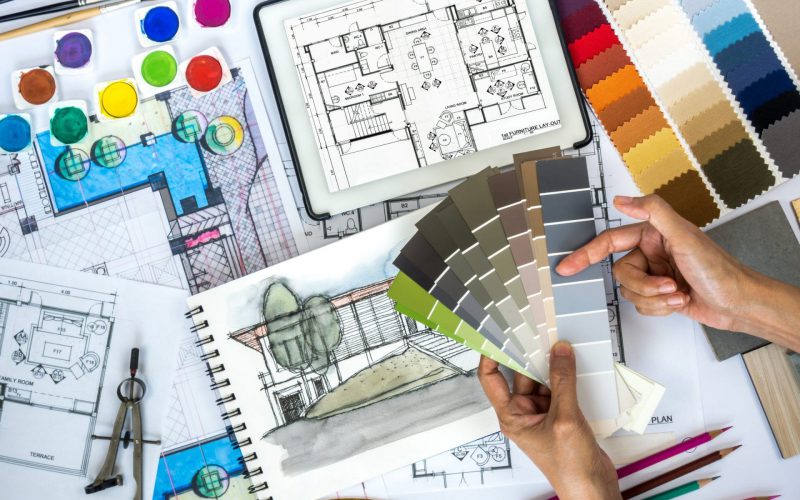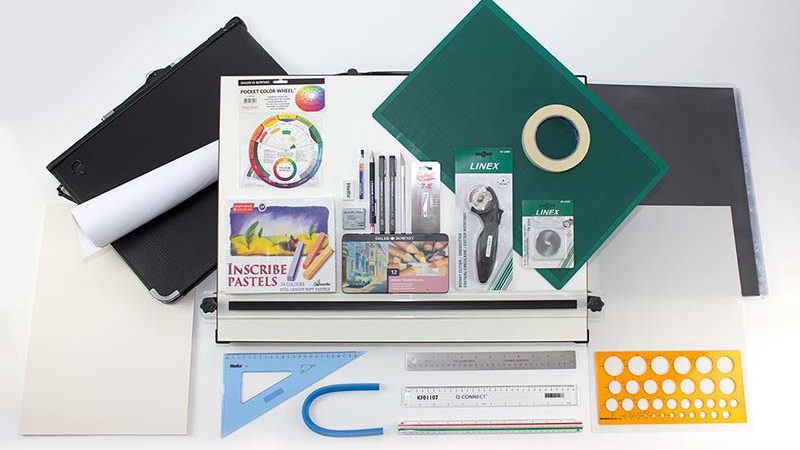10 Tips From The UK’s Top Online Interior Design Academy
Following on from our recent blog where we shared our 15 simple steps to help you become and interior designer, we’ve be asked repeatedly whether it’s possible to study interior design online with the same level of success as from a physical design college or university.
As an academy that’s specialised in teaching interior design for over 30 years, we know a thing or two about the subject. Online learning isn’t a new concept, but we’ve been delivering online courses for over 15 years!
Although we offer the option of studying on campus, the majority of our students choose to enrol with us online. With students in over 80 countries, we couldn’t do it any other way!
But does studying a creative subject remotely really work well? It may surprise you, but the short answer is YES! Why? Because it just makes sense. And for so many reasons.

Why Study Interior Design Online?
It’s amazing just how much life has changed since we all became more ‘mobile’. Online learning effortlessly integrates into people’s lives. It can fit around work schedules, family needs and geographical locations.
Can’t dedicate your life to a full-time, on-campus program? No worries! Thanks to online learning, you can still get a good education, without having to leave home!
But wait – what if you’re studying a subject like interior design where you need to work with real spaces and test out samples of fabric, flooring and paints? Good question! Firstly, not all studying in an online course is actually done online.
Sure, you’ll be using your computer to access learning materials and communicate with your tutor and fellow students. But you’ll also need to work with your hands and learn manual drafting the ‘old-fashioned’ way.
You’ll create real-life concept boards for your clients to see and interact with. And you’ll get to know nearby suppliers and learn how to source material samples (with a bit of legwork!).

All that’s in addition to the online part. You see, interior design has been transformed and reshaped by the digital revolution of the last few decades.
Software tools make planning and developing design schemes so much faster and more accurate. Ordering samples and dealing with suppliers is also an increasingly digital affair. You could say the industry as a whole has shifted online to some extent, and this is reflected in the way the subject is being studied.
Studying interior design online has also been helped by the constant improvements in e-learning development. Online courses have become far more interactive and visual, and better adapted to studying creative subjects like interior design.

So who are online interior design courses for? To today’s generation of digital natives, studying via the internet is just another extension of all their other online activities.
If you go online to socialise, shop, work and find entertainment… isn’t it natural that you’ll also want to study online and qualify as a designer through convenient online courses?
But it’s not just millennials and generation Z that are embracing a digital education in design. Far from it: Online learning is definitely not ageist!
Here at the NDA, we have students from the age of 16, all the way up to 70+.
Consider the more mature interior design fans who are looking for a career change in their thirties, forties and beyond.
With online and distance learning, it’s so much simpler to level up their skills and step out into a world of new career prospects. Online learning offers more flexibility to those with the busiest lives.
With all these benefits, it’s no surprise that the digital route is increasingly being taken by learners of all ages, all around the world.
Here are ten reasons why aspiring designers are choosing to log on and study interior design online, from the comfort of their own homes.
1. Virtual Studios
There will always be incredible value in face-to-face learning. The personal interaction, exchange of ideas, spontaneous discussions, and just the feeling of being part of a group with a shared interest and objective.
But with the latest advancements in distance learning, it’s becoming easier and easier to replicate the feeling of being in a design studio. Social media platforms are a prime example of where digital tools can still make you feel included and part of something. In fact, with online learning you’ll be a part of something even bigger!
It’s fair to say that e-learning has come a long way from its days of dull pages of text delivered online.
"Today’s online learning is varied, interactive, and so much more enjoyable. It combines the best of independent learning with opportunities for student interaction and a virtual class experience."
Take the National Design Academy, for example: our online learning portal has been custom designed to suit the learning content we deliver and the way we like to interact with our students. There’s a forum that brings together students from across the world to encourage the sharing of questions, ideas and experiences.

We also offer a rich resource library with lots of how-to guides, video tutorials, templates and technical information. You can schedule a video chat with your tutor for more in-depth discussions, or view examples of previous student work exhibited in virtual galleries to find guidance or inspiration.
2. Technology is Only Improving
For those passionate about interior design, studying it and pursuing a design career may once have seemed like a far-fetched dream without giving up the day job and returning to college or university. But not anymore!
Thanks to the Internet, professional courses have become far more accessible to people, regardless of their work, home, geographic or economic situations.
Technology is advancing at a pace that’s allowing online learning to be used with ease. And people really are embracing the opportunity!
Looking at some of the numbers, the global e-learning industry has grown by a whopping 900% since 2000, and it’s expected to triple in size from 2020 to 2025.
Online studies have become such a familiar part of the learning process – whether at school, university or work – with 50% of students in higher education institutions having taken an online course in the past year.
As Internet penetration increases in more regions around the world and lifestyles become more digital, online learning in general is becoming more mainstream.
And with this, the range of fields studied online are widening, with more students opting to learn subjects like interior design.

3. Equal Access to Quality Education
How do you unlock your goldmine of design potential if you’re based in an area with limited options for art and design programs? Access to a good education is something that all people are entitled to – and online learning plays a key role in making this possible. With distance learning, regardless of where you are, you can still go to a reputable school and get a high-quality education.

At the National Design Academy, for example, our students from various countries are getting access to a British education that is recognized by the UK government and trusted around the world. That’s from our accredited professional diplomas, through to our degrees. This makes it possible for those with a passion for interior design to pursue their studies, qualify globally as designers regardless of where the live.
4. Maximum Flexibility
If there’s one area where online learning trumps a traditional education, it’s flexibility! Not everyone can drop everything, part with their family, and travel to their university of choice to study interior design. Especially if they’re a mature student with a job and kids who’s looking to switch careers. All of these obstacles are easily side-stepped with online learning.
In addition, there are travel, visa, cultural or safety issues that hold back many from pursuing their studies. In this regard, the benefits of e-learning have never been more obvious than during the Coronavirus COVID-19 outbreak. Universities and schools around the world have made a digital shift, allowing millions to stay on their learning paths.
Without online learning, the world’s education sector would come to a grinding halt during disease outbreaks or wars. But with digital learning, the educational process can carry on, regardless of restrictions on population movement and travel.
And even outside of crises, online study offers incredible flexibility that makes the learning experience much easier.
"You can study remotely from your home, a co-working space, while sipping lattes at your favourite café or soaking up sunshine in your garden… the choice is yours."
And imagine having the freedom to study while you travel – it’s not uncommon for our students to continue their studies even while on holiday!
Many NDA students choose to learn online because it gives them the ability to fit their studies in around their family life.
Whether you’re staying at home to raise your children or juggling a job and family life, finding enough hours in the day can be a challenge.
Studying Interior Design online means that you can fit in your learning as and when you have the time. Whether you do a couple of hours an evening when the kids are in bed or study in your lunch break, the flexibility of online learning is one of the most compelling factors.
5. Study and Work
The flexibility in study schedules that comes with online courses allows learners to pursue an education, while maintaining an income from a full-time job.
If you work in a related field, developing your skills online can help you improve your job prospects and advance along your career path. If you’re lucky, your employer may even give you some time off work for your studies if they see it as beneficial to the business.
And what about if you’re a banker or teacher and have discovered that your true calling lies in interior design?
It’s not uncommon for professionals in unrelated fields to discover a creative streak and a growing desire to switch to a design career.
Many of our students and graduates come from different fields and have turned their hobby into a new job.

You might sit there searching for inspiration for your next interior project on Pinterest, well, now you can do it and have it count towards your future. Most students enjoy their studies so much it doesn’t even feel like work!
We’re constantly encouraged by motivational speakers and coaches to pursue work in a field that makes us happy.
Imagine if the only way to do this was to quit our jobs and enrol in a full-time program at the nearest college or university!
That would mean no income for possibly three or four years if it’s a Bachelor’s degree – which is simply not a feasible option for the average person.
With online courses, you get to move forward simultaneously on both the education and employment fronts in your life which is massively beneficial to your mental well-being
Our 5 Best Things About Working from Home explains more about why online courses are good for your health, wealth and overall happiness.
6. Online Interior Design Inspiration is Everywhere!
There’s never been a better time to study interior design online.
There’s an explosion of interest in the subject and no shortage of information and inspiration to be found on social media like Instagram, Pinterest and YouTube, as well as an increasing amount of TV design shows.
Everywhere you look, there are designers sharing examples of their work on social media, blogs providing useful tips and guides, and TV shows providing a glimpse into the trials and tribulations in the life of the average designer.
The sheer amount and variety of content on those channels is a great source of ideas and information for online design students, and a highly useful online resource to complement their studies.
One of the fastest growing apps of the last three years is Pinterest and the platform is almost made for budding interior designers! It’s like digital scrapbooking or mood-boarding and absolutely wonderful for finding interior design inspiration.
Instagram is another visual platform where our students find ideas for their interior schemes and show off their latest work.
All of the resources you need to study an online interior design course are out there already, for free! You just need the right guidance to help you put your ideas into practice.

7. Affordability
There’s no denying it: the cost of a design school education is an important consideration.
It can be a huge factor in choosing where to study and a significant barrier in the ability to even study at all. This is another area where online learning offers maximum benefits.
"The costs of online learning are usually far more competitive than their equivalent on-campus options. This means that you can still afford to go to a good design school – without having to start your career burdened with massive student loans."
The reason for this is because overheads are lower.
There are major savings in not having to establish and run a large campus when your students are studying from home.
No cleaning costs, no buildings to maintain, no equipment to buy. This enables an online university or college to pass significant savings onto their students.
Degrees at the National Design Academy have around 40% lower fees than other interior design university courses. We are also able to offer progression scholarships to students who have completed a Diploma course and wish to continue their learning to BA level.
All because of online learning.
8. Self-paced Learning
Studying interior design online offers the great advantage of being able to set your own individual learning pace. You set a schedule that suits your lifestyle and learning preferences, whether that happens to be slow or fast paced.
Those who prefer a slower learning pace may find themselves disadvantaged within a rigorous class schedule. On the other hand, the faster learners may find themselves feeling demotivated and unchallenged with the general learning progress. Online courses level the playing field in this aspect.

It also gives you the ability to pause video tutorials and re-watch them later. No more frantic note-taking during lectures! If there’s something you didn’t quite understand the first time around, you can watch it again.
9. More Time to Research and Specialise
When it comes to time efficiency, online learning rules.
Studying interior design online means that there’s no wasted travel time or additional study time for electives like there is in traditional universities.
This means more time to direct your learning based on your own preferences, and more time to do research into specific areas of interest.
It lets you as the student drive your own learning experience and find the motivation within yourself to learn and develop.
Self-driven learning is also increasingly being adopted in traditional school structures that recognise the importance of putting the student in the driver’s seat and allowing them to tailor their education to the field they actually want to work in.
Specialist art and design schools and colleges are becoming more commonplace and that way, you know you’re learning with specialists in the subject.
Delivering online courses has allowed us to specialise too.
Did you know, the NDA are the only online interior design university to offer specialist courses in Heritage Design, Retail Design and Outdoor Living?
Although they aren’t our most popular online courses, we have no lecture halls to fill so we can continue to offer niche courses to help our students to specialise in their passion.
10. Easy Access to Design Tools
If a subject requires special equipment that’s hard to acquire, that can become an obstacle to online learning. Thankfully that’s not the case with studying interior design online – you only need very simple tools.
Your basic toolkit consists of items that can be easily bought from a stationary shop, like a scale rule, A3 paper and tracing paper, drawing pencils, paints and colours, and a drawing board if preferred.

Obviously, students will also need a computer and Internet connection.
In addition, it’s highly advisable today for professional designers to be skilled with design software like AutoCAD and SketchUp.
These can easily be downloaded from the providers’ websites and there are student versions for a discounted price.
It’s typical to learn how to use these programs online – through either free tutorials on YouTube or paid short courses. Again, the tools are out there, all online!
At the National Design Academy, we offer a bunch of resources to make the study process as easy and convenient as possible.
These include comprehensive student toolkits for project work, global supplier directories, and design software tutorials.
Our Virtual Learning Studio is just that. A digital version of a real interior design studio, with bells on!
“Your design should be good enough to speak for itself, even in the form of a simple sketch. These digital tools are just adding an extra boost – especially if hand-drawing is not your strong point.”
Many of these programs can be learned through free tutorials on YouTube or by enrolling on a short course such as Udemy’s Master SketchUp.
Are You Ready to Make the Digital Shift?
The doors to studying interior design have burst open thanks to the immense possibilities of online learning. And it seems they’re going to remain wide open for a very long time. Now’s your chance to take advantage and chase your creative dreams!
If you’ve decided to study interior design online but don’t know what the best option and format is for you, make sure to do your research, study the different options available and weigh up all the pros and cons.
For beginners in interior design, a Diploma is a great place to start. Make sure your course is accredited though as otherwise it won’t be recognised as a true ‘qualification’. We have a blog which explains the difference between hobbyist courses and accredited interior design courses.

If you’ve already studied a design course in the past or have some practical experience of design but not the qualifications to back it up, studying an online interior design degree could be the way to finally qualify. The National Design Academy offers Bachelor’s through to Master’s level.
We’ve been teaching interior design courses for over 30 years, with online options for over 15 years. If you’re ready to take the plunge and make your passion for interior design more than just a hobby, study with the experts!



5 responses
Could you kindly send more registering information,requirements and fees for interior design.
Hello Thabo,
You can find all the information you will need on our Courses page – https://www.nda.ac.uk/study/courses/ and also information about how to register and enrol/apply here – https://www.nda.ac.uk/study/how-to-enrol/ 🙂
Interested to interior design for short course
Hi, you can find all information on the course page – https://www.nda.ac.uk/study/courses/short-courses/interior-design/ If you would like to enrol please follow the link – https://www.nda.ac.uk/study/how-to-enrol/ Alteratively please email hello@nda.ac.uk or use the live chat widget at the bottom left corner of your screen 🙂
Thanks for sharing a beautiful blog.